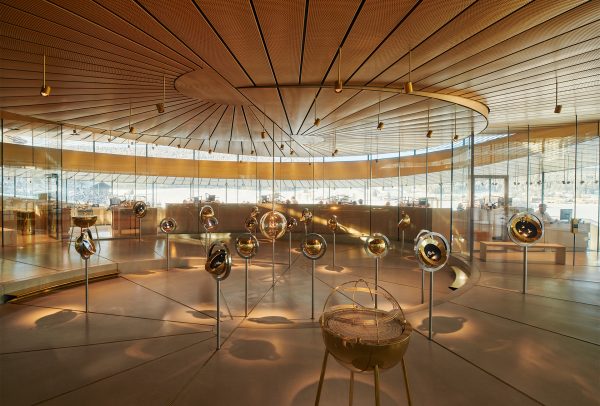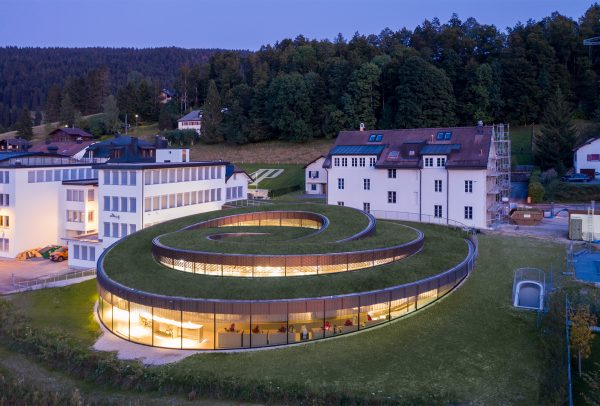These past years have seen museums worldwide rethink the forms an exhibition can take, finding novel ways to stage objects, adding to the experience through multimedia, and in some cases breaking out of the exhibition mould altogether. Audemars Piguet has chosen a somewhat different approach for its Musée Atelier, which opened to the public (currently via reservations only) on June 25 on the historic site in Le Brassus in the Jura Mountains. Here, the building itself is the showcase for what lies within. The museumgoer, having passed through the original workshop premises, arrives in the impressive entrance hall that affords a sweeping view of the countryside all around. But the best is yet to come, namely a “physical” interpretation of the daring and innovation that are hardwired into this family firm, established in 1875 and – a rare thing in the industry – still in the hands of the founding family.
A museum imagined as a watch
This striking construction is the work of Danish architect Bjarke Ingels and his BIG architectural practice, whose other projects include the Google Campus and the Two World Trade Center tower in New York. Its spiral form blends into the surrounding valley, as though corkscrewed into the grassy hill that runs to a small wetland at the foot of the slope. In a feat of engineering, curved glass walls made from panes several layers thick act as supporting walls for the concrete slab roof. They are half-encased in a brass mesh which helps regulate light and temperature inside. Evidence of the attention paid to detail is everywhere: The curve of the glass walls is calculated to prevent visual distortion, thereby ensuring total transparency no matter where the visitor stands. The double spiral shape, coiling clockwise then counter-clockwise, is a metaphor for the spring that beats inside a mechanical watch movement.

This “museum imagined as a watch” is in fact the continuation of an existing exhibition space. In 1992 Audemars Piguet transformed the original building and Audemars family home, dating from 1868, into a museum that was extended a first time in 2004. As part of the new project, it has been fully renovated and now welcomes visitors in an atmosphere of wood and stone patinated by time. This “Maison des Fondateurs”, which connects to the glass spiral, houses the Manufacture’s archives as well as its Heritage division. It is also the head office of the Audemars Piguet Foundation which since 1992 has contributed to forest conservation. The restoration workshop has found its home on the very top floor, where daylight is most abundant and where Audemars Piguet came into existence 145 years ago. The vaulted cellar is set aside for temporary exhibitions that will reflect the brand’s international renown.
A fascinating world
The discovery begins with a family tree that places visitors within the historical perspective of a Maison whose roots stretch back to the thirteenth century for the Piguets and to the sixteenth century for the Audemars. Both these founding fathers were quick to demonstrate an almost natural inclination for the grandes complications that have forged the Manufacture’s reputation. From historic timepieces to contemporary creations, the visitor is treated to a feast of perpetual calendars, minute repeaters and chronographs, a prelude to the “star of the show”: the ultra-complicated Universelle pocket watch. Produced in 1899, its 1,168 components drive 21 functions. Continuing through the spiral, more exceptional timepieces are revealed, whether in terms of miniaturisation, extra-thin movements or decoration and design. The exhibition also relates the Maison’s international success, winning admirers of the likes of the Shah of Iran and President Dwight Eisenhower.

Emphasising the human skill of watchmaking, Audemars Piguet has chosen to relocate two of its most prestigious workshops (or “ateliers”) inside the glass spiral. In the Grandes Complications workshop, watchmakers hand-assemble the most intricate and complex timepieces, while artisans in the Métiers d’Art workshop pore over certain gem-set pieces. The exhibition would not be complete without a special section on the Royal Oak, designed in 1972 by Gérald Genta, and its younger sibling, the Royal Oak Offshore introduced in 1993, showing some of the many interpretations of these eternally popular designs. It would have been easy to overwhelm visitors; instead the exhibition presents a thoughtfully curated selection of 300 watches that demonstrate the full scope of Audemars Piguet’s expertise throughout the ages. In a magnificent showcase that can also call the Vallée its home.























